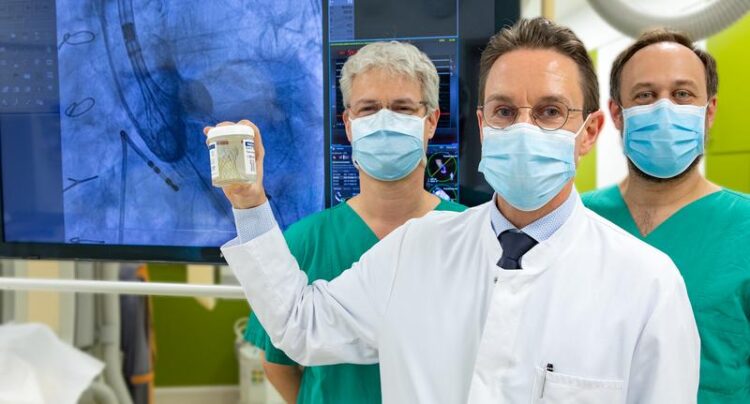Defective heart valve replaced with new TAVI system

Professor Bauersachs with the new TAVI system in the foreground and Professors Dr Julian Widder (left) and Dr Tibor Kempf.
Copyright: MHH/ Karin Kaiser
Evolut™ PRO+ offers more blood flow with a smaller construction.
Narrowing of the aortic valve, known as aortic valve stenosis, is the most common heart valve defect in old age. The valve leaflets of the aortic valve are thickened and have difficulty opening and closing. A heart valve replacement is the only treatment option for aortic valve stenosis. For many patients today, a catheter-based replacement of the aortic valve, or TAVI (Transcatheter Aortic Valve Implantation), is a safe and gentle way to replace the diseased heart valve on the beating heart, usually without a general anaesthetic.
The new TAVI system (Evolut™ PRO+), which was implanted in Northern Germany for the first time on 1 June by the heart team led by specialist Professor Dr Julian Widder of the Clinic for Cardiology and Angiology, offers advantages with its special design: The new valve leaflets of the prosthesis lie above the natural aortic valve ring. This allows for a wider valve opening than with other types of valves.
“The larger the valve opening area, the easier it is for the heart muscle to pump blood into the body,” Professor Dr. Bauersachs, Director of the Department of Cardiology and Angiology, explains the effect. On 1 June, a 91-year-old patient from the Baltic Sea resort of Boltenhagen received the new system in a 45-minute procedure. “She will already be able to leave the clinic in a few days,” adds the cardiologist.
The size of the patient’s access vessels, in turn, determines whether the procedure can be applied via the groin. “In about ten percent of our patients, the vessel diameter is just 5 to 5.5 millimetres. For these patients, we need systems that are as narrow as possible so that the new heart valve can be safely advanced to the heart,” explains Professor Widder. The slim insertion system of the new TAVI system ensures easier access even for patients with a small vessel diameter of only 5 millimetres.
The valve leaflets made of biological material (pericardium) are sewn into a flexible framework made of a special metal composition (nitinol). This allows the prosthesis to adapt particularly well to the respective valve and aorta. An additional coating on the framework of the valve also ensures a better seal. “This gives us more options for finding the right valve prosthesis for each of our patients,” Professor Bauersachs emphasises.
SERVICE:
For more information, contact Prof. Dr. Julian Widder, phone (0511) 532-3840, kardiologie@mh-hannover.de.
Media Contact
All latest news from the category: Medical Engineering
The development of medical equipment, products and technical procedures is characterized by high research and development costs in a variety of fields related to the study of human medicine.
innovations-report provides informative and stimulating reports and articles on topics ranging from imaging processes, cell and tissue techniques, optical techniques, implants, orthopedic aids, clinical and medical office equipment, dialysis systems and x-ray/radiation monitoring devices to endoscopy, ultrasound, surgical techniques, and dental materials.
Newest articles

Ion thermoelectric conversion devices for near room temperature
The electrode sheet of the thermoelectric device consists of ionic hydrogel, which is sandwiched between the electrodes to form, and the Prussian blue on the electrode undergoes a redox reaction…

Zap Energy achieves 37-million-degree temperatures in a compact device
New publication reports record electron temperatures for a small-scale, sheared-flow-stabilized Z-pinch fusion device. In the nine decades since humans first produced fusion reactions, only a few fusion technologies have demonstrated…

Innovative microscopy demystifies metabolism of Alzheimer’s
Researchers at UC San Diego have deployed state-of-the art imaging techniques to discover the metabolism driving Alzheimer’s disease; results suggest new treatment strategies. Alzheimer’s disease causes significant problems with memory,…





















